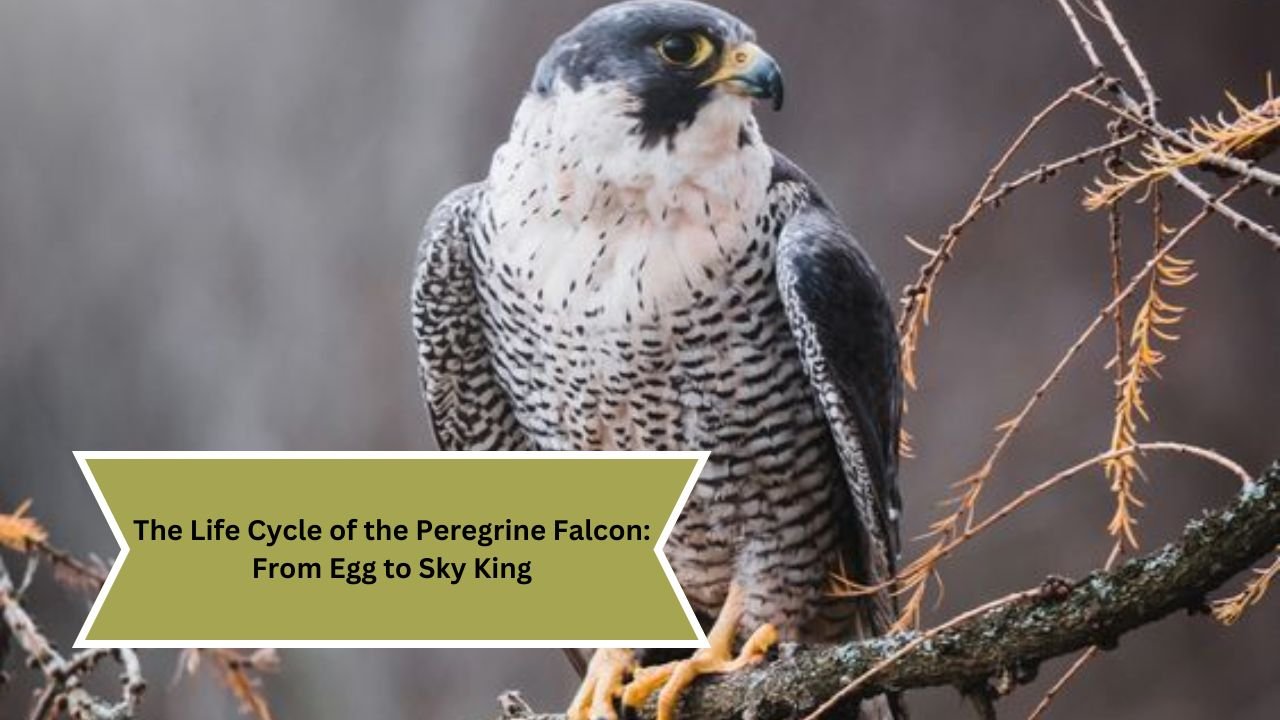The peregrine falcon (Falco peregrinus), renowned for its incredible speed and striking appearance, is a symbol of agility and power in the avian world. With its distinctive blue-gray feathers, black markings, and striking yellow facial markings, this bird captures the imagination of bird watchers and nature enthusiasts alike. However, beyond its beauty lies a fascinating life cycle that unfolds from a tiny egg to a magnificent aerial hunter. This article delves into the stages of the peregrine falcon’s life cycle, highlighting its unique behaviors and adaptations along the way.
1. Egg Stage: The Beginning of Life
The life cycle of the peregrine falcon begins with the laying of eggs. Breeding typically occurs in the spring, with female falcons laying a clutch of 3 to 6 eggs. These eggs are usually laid in a scrape, a shallow depression often found on ledges of cliffs or tall buildings, where the falcons prefer to nest.
Incubation Period
The female peregrine falcon incubates the eggs for approximately 29 to 32 days. During this time, she remains largely on the nest, relying on the male to provide food. The male hunts for small birds, which make up the majority of the falcon’s diet, and brings the prey back to the nest to feed the female and, eventually, the chicks.
Temperature Regulation
Maintaining the right temperature is crucial for the development of the embryos. The female falcon uses her body heat to keep the eggs warm, often rotating them to ensure even incubation. The eggs are typically white to pale in color with speckles, providing some camouflage against the rocky surfaces where they are laid.
2. Hatching: The Emergence of Chicks
Once the incubation period is complete, the eggs begin to crack, and the chicks emerge—a process called hatching. This is a critical stage in the life cycle, as the chicks are initially helpless and rely entirely on their parents for survival.
Nestling Stage
The chicks are covered in down feathers, which provide some insulation but leave them vulnerable. They are blind and unable to regulate their body temperature initially. The female continues to care for them, keeping them warm and sheltered from the elements. The male provides food, bringing back small birds that the female tears apart for the chicks.
Rapid Growth
The nestlings grow rapidly, gaining weight and developing feathers over the next few weeks. By the time they are around two weeks old, they will begin to open their eyes and can start to move around the nest. This stage is crucial for their physical development, as they learn to assert themselves and compete for food.
3. Fledging: Taking to the Skies
After approximately 5 to 6 weeks, the chicks are ready to fledge, or take their first flight. This is an exhilarating yet risky time for the young peregrine falcons, as they must master the art of flying to become independent hunters.
Learning to Fly
Fledging usually occurs between 5 to 6 weeks of age. Initially, the chicks make short flights from the nest, testing their wings and gaining confidence. They practice flapping and gliding, honing their coordination and strength. During this period, the parents continue to support them, providing food and encouragement.
Exploration and Play
As the chicks become more adept at flying, they begin to explore their surroundings. They engage in playful behaviors, chasing one another and practicing their aerial skills. This play is crucial for developing their hunting techniques, as they learn how to maneuver in the air and respond to potential threats.
4. Juvenile Stage: Independence and Survival
Once the chicks have successfully fledged, they enter the juvenile stage of their life cycle. During this time, they gradually transition from reliance on their parents to becoming independent hunters.
Foraging Skills
Initially, juvenile peregrine falcons may struggle to catch their own prey. They rely on their parents for food for several weeks after fledging. The parents may continue to bring food to the nest while the young birds learn to hunt. This stage is essential for their survival, as they develop the skills necessary to capture prey independently.
Territorial Behavior
As the juveniles gain confidence and experience in hunting, they begin to establish their own territories. They may remain in the vicinity of their parents for several months but gradually move further away to seek out their own hunting grounds. This transition is crucial for reducing competition among falcon populations and ensuring sustainable hunting practices.
5. Adult Stage: Mastering the Skies
By the time peregrine falcons reach sexual maturity at around 1 to 3 years of age, they are fully equipped for a life of independence. Adult falcons are characterized by their remarkable hunting abilities and complex social behaviors.
Hunting Techniques
Peregrine falcons are renowned for their incredible speed, capable of reaching speeds over 240 mph during their characteristic hunting stoop (high-speed dive). They primarily prey on medium-sized birds, using their keen eyesight and agile flight to spot potential meals from great distances. Their hunting strategies often involve high-altitude flights, followed by a sudden, powerful dive to catch their prey off-guard.
Breeding and Nesting
Once they reach maturity, adult peregrine falcons engage in courtship displays and seek out nesting sites to begin the cycle anew. Breeding typically occurs in the spring, with pairs returning to the same nesting sites year after year. The male performs aerial displays to attract a mate, showcasing his agility and prowess.
6. Conservation Status and Challenges
Despite their impressive adaptations, peregrine falcons have faced significant challenges in the past, particularly due to habitat loss and the effects of pesticides such as DDT. These chemicals led to thinning eggshells, resulting in decreased hatching success and population declines. However, conservation efforts have helped to stabilize and recover peregrine falcon populations in many regions.
Conservation Efforts
Today, peregrine falcons are protected under various conservation laws, and numerous organizations work to monitor and support their populations. Nesting platforms have been established in urban areas, allowing falcons to thrive in habitats that were once unsuitable. Public awareness campaigns have also helped educate communities about the importance of protecting these magnificent birds.
7. Conclusion
The life cycle of the peregrine falcon is a remarkable journey from fragile eggs to powerful hunters of the skies. Each stage of their life—from hatching to fledging and eventual independence—illustrates the incredible adaptations and resilience of these birds.
Understanding the intricacies of the peregrine falcon’s life cycle not only deepens our appreciation for these avian marvels but also highlights the importance of ongoing conservation efforts to ensure their survival. As we continue to protect their habitats and promote awareness, we can hope that future generations will witness the majestic flight of the peregrine falcon soaring through the skies as the true kings of the air.
| HOME | CLICK HERE |
| PEREGRINE | CLICK HERE |

